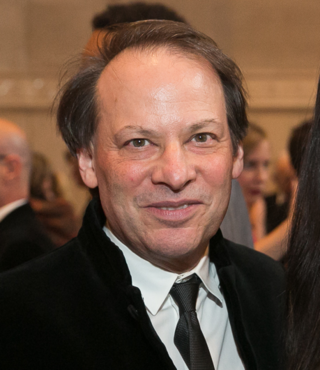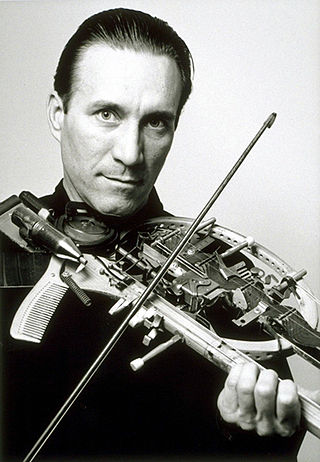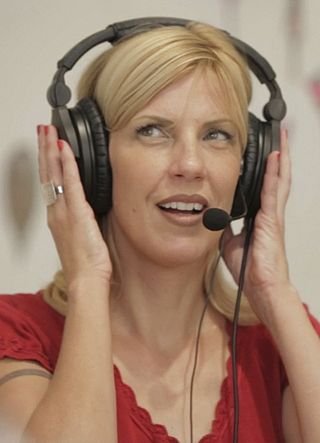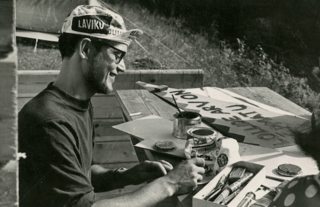Related Research Articles

The Metropolitan Museum of Art, colloquially referred to as the Met, is an art museum in New York City. It is the largest art museum in the Americas and fourth-largest in the world.

Adam Gopnik is an American writer and essayist. He is best known as a staff writer for The New Yorker, to which he has contributed non-fiction, fiction, memoir, and criticism since 1986.
Calvin Tomkins is American an author and art critic for The New Yorker magazine.

Steina Vasulka and Woody Vasulka are early pioneers of video art, and have been producing work since the early 1960s. The couple met in the early 1960s and moved to New York City in 1965, where they began showing video art at the Whitney Museum and founded The Kitchen in 1971. Steina and Woody both became Guggenheim fellows: Steina in 1976, and Woody in 1979.

The Quimbaya (/kɪmbaɪa/) were a small indigenous group in present-day Colombia noted for their gold work characterized by technical accuracy and detailed designs. The majority of the gold work is made in tumbaga alloy, with 30% copper, which colours the pieces.

Kenneth Lee Butler is an American artist and musician, as well as an experimental musical instrument builder. His Hybrid musical instruments and other artworks explore the interaction and transformation of common and uncommon objects, altered images, sounds and silence. The idea of bricolage, essentially using whatever is "at hand", is at the center of his art, encompassing a wide range of practice that combines live music, instrument design, performance art, theater, sculpture, installation, photography, film/video, graphic design, drawing, and collage.
Marina Rosenfeld is an American composer, sound artist and visual artist based in New York City. Her work has been produced and presented by the Park Avenue Armory, Museum of Modern Art, Portikus (Frankfurt), Donaueschinger Musiktage, and such international surveys as documenta 14 and the Montreal, Liverpool, PERFORMA, and Whitney biennials, among many others. She has performed widely as an improvising turntablist, and served as co-chair of Music/Sound in the MFA program at the Milton Avery School of the Arts, Bard College, from 2007 to 2020. She has also taught at Harvard, Yale, Brooklyn College, and Dartmouth.

Haig Papazian is a Lebanese-Armenian multidisciplinary artist, composer, and architect born in Beirut and currently based out of New York. He is a founding member and violinist of Lebanese pop band Mashrou' Leila.

"William", also known as "William the Hippo", is an Egyptian faience hippopotamus statuette from the Middle Kingdom, now in the collection of the Metropolitan Museum of Art in New York City, where it serves as an informal mascot of the museum. Found in a shaft associated with the Upper Egyptian tomb chapel of "The Steward, Senbi", in what is now Meir, William dates from c. 1961 BC – c. 1878 BC, during the reigns of Senusret I and Senusret II. This 20 cm figurine in Egyptian faience, a clay-less material, has become popular not only for his endearing appearance, but also because his defining characteristics illustrate many of the most salient facets of craft production in ancient Egypt during this time.

Oliver Beer is a British artist who lives and works in Kent and Paris. He graduated in 2009 from the Ruskin School of Drawing and Fine Art, University of Oxford, England and in 2007 from the Academy of Contemporary Music in England.

Jennie C. Jones is an African-American artist living and working in Brooklyn, New York. Her work has been described, by Ken Johnson, as evoking minimalism, and paying tribute to the cross-pollination of different genres of music, especially jazz. As an artist, she connects most of her work between art and sound. Such connections are made with multiple mediums, from paintings to sculptures and paper to audio collages. In 2012, Jones was the recipient of the Joyce Alexander Wien Prize, one of the biggest awards given to an individual artist in the United States. The prize honors one African-American artist who has proven their commitment to innovation and creativity, with an award of 50,000 dollars. In December 2015 a 10-year survey of Jones's work, titled Compilation, opened at the Contemporary Arts Museum in Houston, Texas.
The year 2016 in art involves various significant events.

The Met Breuer was a museum of modern and contemporary art at Madison Avenue and East 75th Street in the Upper East Side of Manhattan, New York City. It served as a branch museum of the Metropolitan Museum of Art from 2016 to 2020.
Kevin Beasley is an American artist working in sculpture, performance art, and sound installation. He lives and works in New York City. Beasley was included in the Whitney Museum of American Art's Biennial in 2014 and MoMA PS1's Greater New York exhibition in 2015.

Margaret Noble is an American conceptual artist, sound artist, installation artist, teacher and electronic music composer.

Arthur Jafa is an American video artist and cinematographer.

Firas Abou Fakher is a Lebanese composer, musician, producer and writer. He is best known as a composer, guitarist, and keyboardist with indie rock band Mashrou' Leila and the co-founder of Last Floor Productions.

Kaarel Kurismaa is the first and one of the most important sound art and sound installation artists in Estonia. His work also expands into the field of painting, animation, public space monumental art, stage installations. In Estonian art history, Kurismaa’s significance lies mostly in the pioneering work with kinetic art and with keeping its traditions alive. Kurismaa stands as one of Estonian sound art scene’s central icons. His idiosyncratic work serves as a foundation for Estonian sound and kinetic art.

Carl Gerges is a Lebanese musician and architect. Gerges has been featured on the cover of L'officiel Levant and on the cover of Architectural Digest Middle East as an architect; and on the Middle East edition of Rolling Stone magazine and GQ Middle East as a musician.

Before Yesterday We Could Fly: An Afrofuturist Period Room is an art exhibition at the Metropolitan Museum of Art in New York City. The exhibit, which opened on November 5, 2021, uses a period room format of installation to envision the past, present, and future home of someone who lived in Seneca Village, a largely African American settlement which was destroyed to make way for the construction of Central Park in the mid-1800s.
References
- 1 2 Smith, Steve (2019-07-10). "In Review: Oliver Beer, Vessel Orchestra". National Sawdust Log. Retrieved 2019-09-10.
- ↑ Walls, Seth Colter (2019-07-16). "He Turned the Met Museum's Collection Into an Orchestra". The New York Times. Retrieved 2019-09-10.
- ↑ Schaefer, John (2019-07-12). "The Secret Sound Of The Vessel Orchestra". WNYC. Retrieved 2019-09-10.
- ↑ Gopnik, Adam (2019-08-19). "If You Listen" . The Talk of the Town. The New Yorker. Vol. 95, no. 23. p. 15. Online: "Making Music from the Met's Forgotten Treasures". The New Yorker. 2019-08-12. Retrieved 2019-09-10.
- ↑ Rosati, Lauren (2019-07-02). "In Conversation: Oliver Beer's Vessel Orchestra and the Democracy of Sound". The Met. Retrieved 2019-09-27.
- ↑ Oliver Beer: Vessel Orchestra (Exhibition guide). New York: The Metropolitan Museum of Art. 2019. OCLC 1109395603. Archived from the original on 2022-04-17.